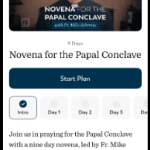I recently returned from a trip to Europe – Italy, Swizerland and France. I’ll be posting a series of posts about what I saw there.
Rome, the Eternal City, has me bewitched. Our first full day there, we awoke early and started at St. Peter’s Square, basically getting the lay of the land before we went there for real on Sunday for Mass. Then we took a walk in the general direction of the Pantheon, stopping practically every other block as a result of a recurring conversation that went like this:
“That place looks interesting — should we take a look inside?”
“Sure.”
We walk in the door only to gasp in awe at some Baroque masterpiece-filled jewel-box of a Church.
“Holy … I mean, wow!”
We saw the Pantheon, the Forum, the Coliseum. The crowning glory of the day was the Archbasilica of St. John Lateran. I was looking forward to seeing it, and I was not disappointed. It was built in the 300s, has been expanded and enlarged several time through the centuries, it is in excellent repair, and it gave me an appreciation of just how good the imperial Romans were at monumental architecture.
But rather than a travelogue, dear readers, I thought I’d talk this time about what I’ve learned so far about America since I’ve been here. I’ve mentioned in this space that I’ve visited almost all the U.S. states, so I believe I have a pretty good sense of what America is like. One good reason for traveling abroad is to gain a deeper understanding of your own country by seeing how other nations do things, and comparing it to how your own country works.
Someone from Africa once remarked to New York Times foreign correspondent Chris Hedges that “Americans must be the loneliest people in the world.” My time in Rome has shown me the poignant truth of that remark.
Almost from our first moments in Rome, taking the train from the airport to Roma Termini, the city’s main train station, there was something about the train that seemed essentially different than the American train rides I’ve taken. The feeling stayed with me when we transferred to the Metro, Rome’s subway system, that took us to our hotel.
At first I could not quite put my finger on what exactly was different. While European public transportation has been uniformly excellent in my experience — their trains and subways are quieter, run at far faster speeds and are a vastly more convenient way of getting around than comparable systems in America — in terms of design and function, Italy’s train systems are not hugely different from American systems, so that wasn’t what I was noticing.
I finally realized that it wasn’t what I was seeing but what I was hearing that struck me as unusual: While Americans on trains tend these days to travel in a kind of electronic fog, surfing the Web on a variety of devices, checking email, updating Facebook statuses and so on, people on Italian trains and subways talk to one another. It’s a subtle thing, but it illustrates an essential difference in how Americans and Italians relate to one another.
Once we left the trains and made our way to our hotel, I saw more evidence all around that Italians structure their society differently than Americans. The streets were teeming with people, but the character of the crowds was not like the purposeful, mission-focused rush of the crowds in Midtown New York or Downtown San Francisco. The streets and neighborhoods of Rome are where the inhabitants of this city not only conduct commerce or go to and from destinations, it is where they live their lives. Walking the leafy streets north of Vatican City, I saw parents out for a stroll with young children in tow, elderly couples greeting friends and family with affection, lovers walking arm in arm and enjoying gelato, groups of priests walking slowly to and from the Vatican, discussing the finer points of theology.
Americans, by contrast, seem almost to go out of their way to avoid each other’s company. While Europeans commute to work together on trains, Americans much more commonly commute to work alone in their cars. Where Europeans get coffee at a local café where they probably know the owner, then consume it on the premises, Americans grab a cup at Starbucks and put it in the cup holder in their car and consume it on the way to work.
Where Americans fill their homes with electronic entertainment systems, and thus in a sense turn inward for entertainment and diversion, Romans seem far more likely to seek entertainment in the real world of cafes, restaurants, theaters and the many and varied public squares and parks that enrich the public realm here.
The public realm in America has always been impoverished relative to Europe and Asia. Land has always been relatively cheap in America, so Americans are far more likely than Europeans to have a backyard, and perhaps a pool, which serve more or less the same function as public squares and parks do in Europe, except for being entirely private.
While American streets are treated as means — that is, places where people get from one place to another — for the citizens of Rome the streets are treated as ends, as places where they can mix it up with their fellow citizens. They take joy in one another’s company.
For them, the joy is not just in the destination but also in the journey. We Americans would do well to remember that.
















